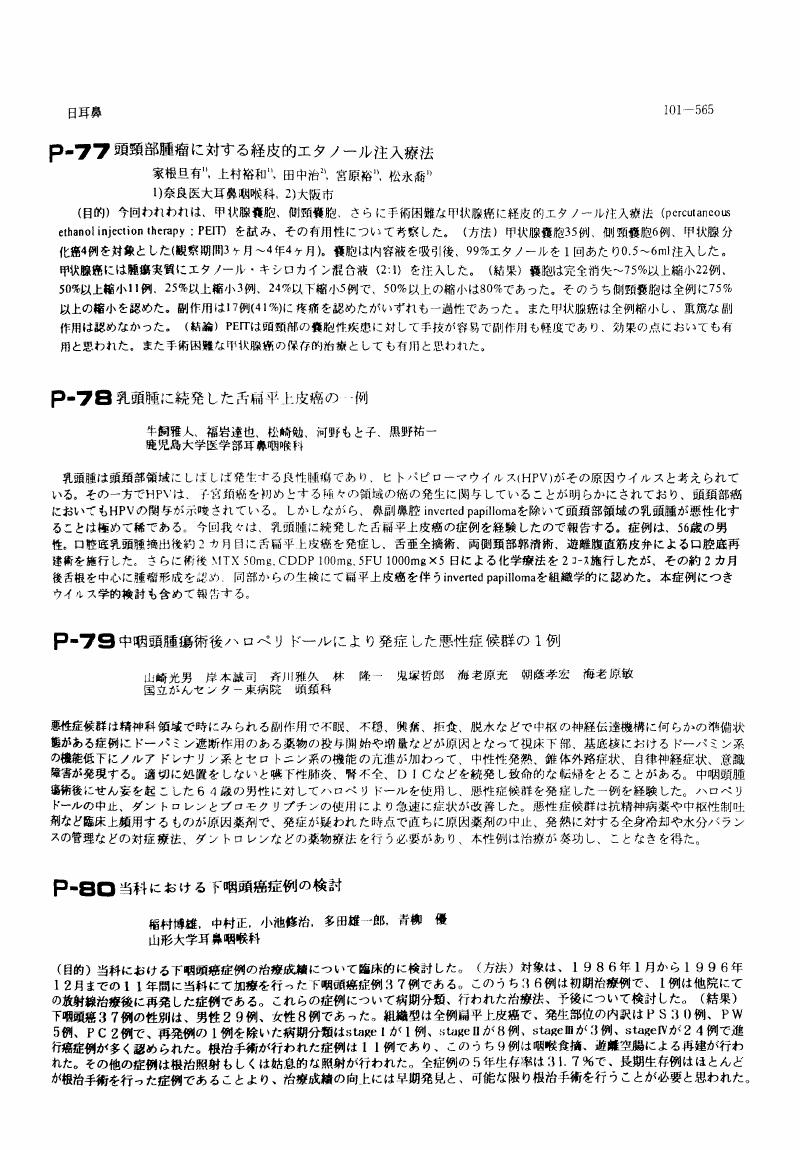2 0 0 0 OA 味覚障害患者の臨床統計
- 著者
- 横田 雅子 家根 旦有 宮原 裕 松永 喬
- 出版者
- 耳鼻咽喉科展望会
- 雑誌
- 耳鼻咽喉科展望 (ISSN:03869687)
- 巻号頁・発行日
- vol.34, no.6, pp.653-658, 1991-12-15 (Released:2011-08-10)
- 参考文献数
- 13
我々は1985年1月より1989年12月までに当科で診療した味覚障害患者, 男性55例, 女性56例, 計111例について統計的観察を試みた。重症度や治療は原因と関係が深く, その原因は口腔内病変, 頭部外傷, 感冒罹患後, 伝導路障害, 全身性, 嗅覚性, 薬剤性, 心因性, 脳血管障害, 原因不明である。この中で, 伝導路障害が最も多く (27%), 口腔内病変, 原因不明と続く。原因別の電気味覚閾値は, 頭部外傷と薬剤性で高く, 全身疾患や心因性では低い。電気味覚閾値と濾紙味覚閾値は比較的良好な正の相関を示し, 特に鼓索神経支配領域で相関性が高い。また亜鉛欠乏が検査し得た症例の60%以上で見られた。ZnSO4で治療した9例中8例で改善した。
1 0 0 0 OA トーンワルト病について
- 著者
- 松永 喬
- 出版者
- 日本口腔・咽頭科学会
- 雑誌
- 口腔・咽頭科 (ISSN:09175105)
- 巻号頁・発行日
- vol.5, no.2, pp.113-118, 1993-03-31 (Released:2010-06-28)
- 参考文献数
- 29
Tornwaldt's disease, which was first described by Tornwaldt as one of the causes of epipharyngitis, is inflammation or abscess of the embryonic remnant cyst of the pharyngeal bursa appearing at the posterior median wall of the epipharynx. Although many cases are asymptomatic, symptoms are often caused by nasal tamponade, trauma, adenotomy, or other mechanical stimuli. Only a few cases have been reported from 1929 till 1992 in Japan. In about the 10th week of embryonic development the pouch, which is made by adhesion of the pharyngeal ectoderm to the notochord at the most cranial end of the notochord, is closed at the orifice (cystic type), or crusts adhere to the orifice without closing (crust type). The symptoms are those of upper respiratory tract infection with obstinate occipital pain, purulent choanal discharge, nasal obstruction, halitosis, feeling of ear fullness, clearing of the throat, etc. Posterior rhinoscopy, simple lateral view X-ray tomography, nasopharyngeal fiberscopy, CT scan and MRI are useful in showing adhesion to the cervical vertebrae. While complete extirpation via a transpalatal approach is desirable, incision or excision of the cyst can also be performed.
- 著者
- 奥田 稔 高坂 知節 三宅 浩郷 原田 康夫 石川 哮 犬山 征夫 間口 四郎 新川 秀一 池野 敬一 松原 篤 稲村 直樹 中林 成一郎 後藤 了 小野寺 亮 遠藤 里見 亀井 民雄 室井 昌彦 馬場 廣太郎 島田 均 舩坂 宗太郎 大橋 伸也 鄭 正舟 小澤 実佳 八木 聰明 大久保 公裕 後藤 穣 服部 康夫 上野 則之 柏戸 泉 大塚 博邦 山口 潤 佃 守 池間 陽子 坂井 真 新川 敦 小林 良弘 佐藤 むつみ 山崎 充代 藤井 一省 福里 博 寺田 多恵 小川 裕 加賀 達美 渡辺 行雄 中川 肇 島 岳彦 齋藤 等 森 繁人 村上 嘉彦 久松 建一 岩田 重信 井畑 克朗 坂倉 康夫 鵜飼 幸太郎 竹内 万彦 増田 佐和子 村上 泰 竹中 洋 松永 喬 上田 隆志 天津 睦郎 石田 春彦 生駒 尚秋 鈴木 健男 涌谷 忠雄 宮國 泰明 夜陣 紘治 森 直樹 田頭 宣治 宮脇 浩紀 青木 正則 小林 優子 高橋 正紘 沖中 芳彦 遠藤 史郎 池田 卓生 関谷 透 奥園 達也 進 武幹 前山 忠嗣 恒冨 今日子 増山 敬祐 浅井 栄敏 土生 健二郎 中崎 孝志 吹上 忠祐 角田 憲昭 渡辺 隆 野口 聡 隈上 秀伯 吉見 龍一郎 茂木 五郎 鈴木 正志 大橋 和史
- 出版者
- 耳鼻と臨床会
- 雑誌
- 耳鼻と臨床 (ISSN:04477227)
- 巻号頁・発行日
- vol.42, no.5, pp.633-658, 1996-09-20 (Released:2013-05-10)
- 参考文献数
- 21
通年性アレルギー性鼻炎患者211例を対象に, KW-467910mg/日 (KW群) の有効性, 安全性および有用性をoxatomide 60mg/日 (OX群) を対照薬として多施設二重盲検群間比較試験により検討した.最終全般改善度の「改善」以上は, KW群61-6%, OX群57.6%で, 両群間に有意差は認められなかつたが, 同等性の検証を行った結果, KW群はOX群と比較して同等ないしそれ以上と考えられた. 概括安全度の「安全性に問題なし」と評価された症例は, KW群68.0%, OX群61.4%で, 両群間に有意差は認められなかった. 主な副作用症状は両群とも眠気であった. 有用度の「有用」以上は, KW群54.9%, OX群50.5%であり両群間に有意差はなかったが, KW群の方がやや有用率が高かった.以上の成績より, KW-4679は通年性アレルギー性鼻炎に対して, 臨床的に有用性の高い薬剤であると考えられた.
1 0 0 0 OA 7頭頸部腫瘤に対する経皮的エタノール注入療法
- 著者
- 家根 旦有 上村 裕和 田中 治 宮原 裕 松永 喬
- 出版者
- 一般社団法人 日本耳鼻咽喉科学会
- 雑誌
- 日本耳鼻咽喉科学会会報 (ISSN:00306622)
- 巻号頁・発行日
- vol.101, no.4, pp.565-565, 1998-04-20 (Released:2008-03-19)
